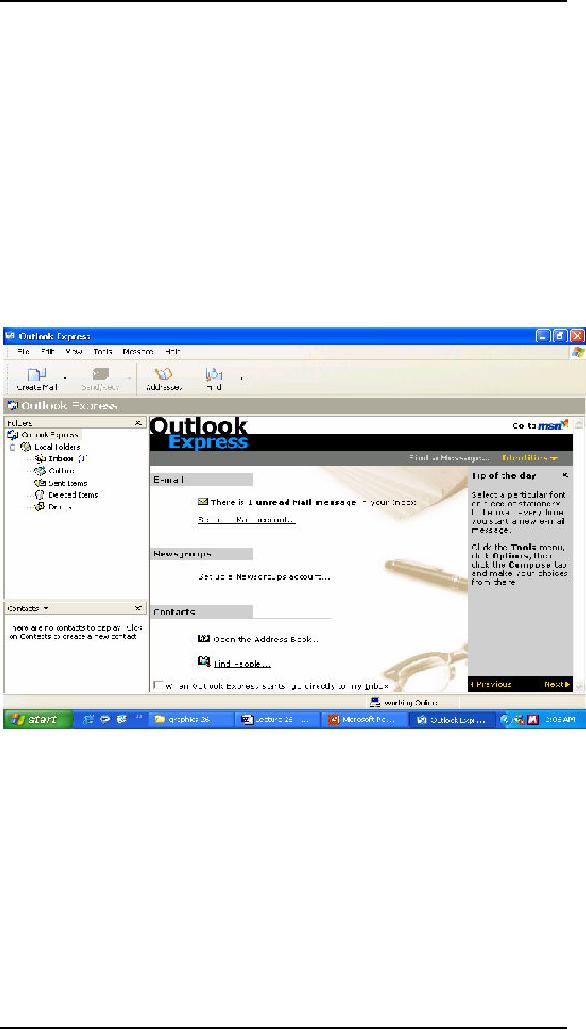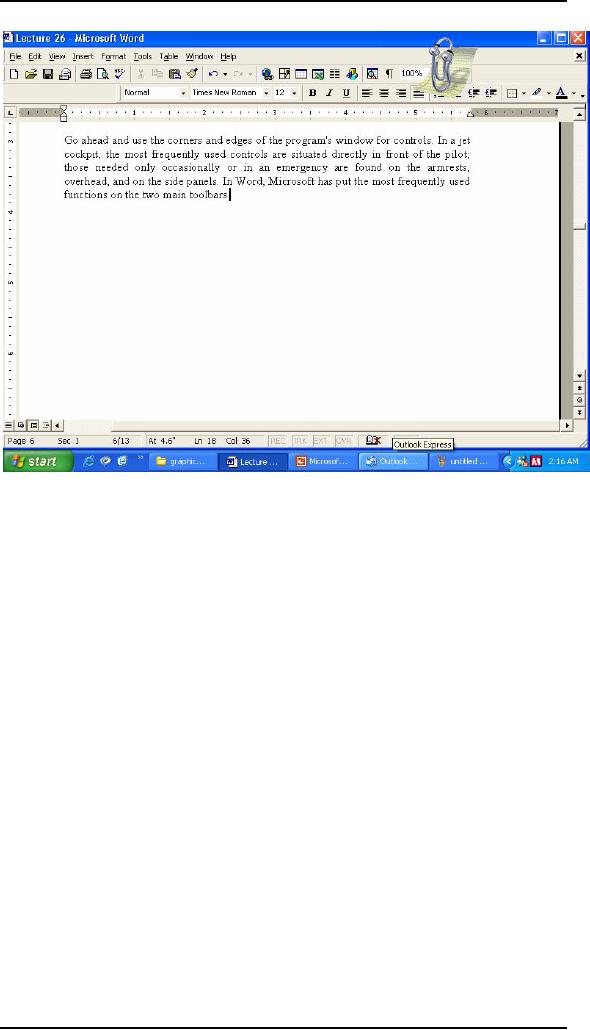 |

Human
Computer Interaction
(CS408)
VU
Lecture
26
Lecture
26. Behavior
& Form Part I
Learning
Goals
As the
aim of this lecture is to
introduce you the study of
Human Computer
Interaction,
so that after studying this
you will be able to:
� Understand
the narratives and
scenarios
� Define
requirements using persona-based
design
Software
Posture
26.1
Most
people have a predominant
behavioral stance that fits
their working role on
the
job:
The soldier is wary and
alert; the toll-collector is
bored and disinterested;
the
actor is
flamboyant and bigger than
life; the service
representative is upbeat
and
helpful.
Programs, too, have a predominant
manner of presenting themselves to
the
user.
A program
may be bold or timid,
colorful or drab, but it
should be so for a
specific,
goal-directed
reason. Its manner shouldn't
result from the personal
preference of its
designer
or programmer. The presentation of
the program affects the
way the user
relates to
it, and this relationship
strongly influences the
usability of the
product.
Programs whose
appearance and behavior conflict
with their purposes will
seem
jarring
and inappropriate, like fur
in a teacup or a clown at a wedding.
I
The
look and behavior of your
program should reflect how
it is used, rather than
an
arbitrary
standard. A program's behavioral
stance -- the way it
presents itself to
the
user --
is its posture. The look
and feel of your program
from the perspective
of
posture
is not
an
aesthetic choice: It is a behavioral
choice. Your program's
posture is
its
behavioral foundation, and
whatever aesthetic choices you make
should be in
harmony
with this posture.
The
posture of your interface
tells you much about
its behavioral stance,
which, in
turn,
dictates many of the
important guidelines for the
rest of the design. As
an
interaction
designer, one of your first
design concerns should be ensuring
that your
interface
presents the posture that is
most appropriate for its
behavior and that of
your
users.
This lecture explores the
different postures for applications on
the desktop.
Postures for the
Desktop
26.2
Desktop
applications fit into four
categories of posture: sovereign,
transient,
daemonic,
and auxiliary. Because each
describes a different set of
behavioral
attributes,
each also describes a
different type of user
interaction. More
importantly,
these
categories give the designer a
point of departure for
designing an interface. A
sovereign
posture program, for
example, won't feel right
unless it behaves in a
"sovereign"
way. Web and other
non-desktop applications have
their own variations
of
posture.
234

Human
Computer Interaction
(CS408)
VU
Sovereign
posture
Programs
that are best used
full-screen, monopolizing the
user's attention for
long
periods
of time, are sovereign
posture application. Sovereign
applications offer a
large
set of
related functions and
features, and users tend to
keep them up and
running
continuously.
Good examples of this type
of application are word
processors,
spreadsheets,
and e-mail applications.
Many vertical applications
are also sovereign
applications
because they often deploy on
the screen for long
periods of time, and
interaction
with them can be very
complex and involved. Users
working with
sovereign
programs often find themselves in a
state of flow. Sovereign
programs are
usually
used maximized. For example, it is hard to
imagine using Outlook in a
3x4 inch
window --
at that size it's not
really appropriate for its
main job: creating and
viewing
e-mail
and appointments (see
Figure).
Sovereign
programs are characteristically used
for long, continuous
stretches of time.
A
sovereign program dominates a
user's workflow as his
primary tool.
PowerPoint,
for
example, is open full screen
while you create a
presentation from start to
finish.
Even if
other programs are used for
support tasks, PowerPoint
maintains its
sovereign
stance.
The
implications of sovereign behavior are
subtle, but quite clear
after you think
about
them. The most important
implication is that users of
sovereign programs
are
intermediate
users. Each user spends time
as a novice, but only a
short period of time
relative
to the amount of time he
will eventually spend using
the product. Certainly
a
new
user has to get over
the painful hump of an
initial learning curve, but
seen from
the
perspective of the entire
relationship of the user
with the application, the
time he
spends
getting acquainted with the
program is small.
235

Human
Computer Interaction
(CS408)
VU
From
the designer's point of view,
this means that the
program should be designed
for
optimal
use by perpetual intermediates
and not be aimed primarily
for beginners (or
experts).
Sacrificing speed and power
in favor of a clumsier but
easier-to-learn idiom
is out of
place here, as is providing only
nerdy power tools. Of
course, if you can
offer
easier
idioms without compromising
the interaction for
intermediate users; that
is
always
best.
Between
first-time users and
intermediate users there are
many people who
use
sovereign
applications only on occasion.
These infrequent users
cannot be ignored.
However,
the success of a sovereign
application is still dependent on
its intermediate,
frequent
users until someone else
satisfies both them and
inexperienced
users.
WordStar,
an early word processing program, is a
good example. It dominated
the
word
processing marketplace in the late
70s and early 80s
because it served its
intermediate
users exceedingly well, even
though it was extremely
difficult for
infrequent
and first-time users.
WordStar Corporation thrived
until its competition
offered
the same power for
intermediate users while
simultaneously making it
much
less
painful for infrequent
users. WordStar, unable to
keep up with the
competition,
rapidly
dwindled to insignificance.
TAKE THE
PIXELS
Because
the user's interaction with
a sovereign program dominates
his session at the
computer,
the program shouldn't be
afraid to take as much
screen real estate as
possible.
No other program will be competing
with yours, so expect to
take advantage
of it
all. Don't waste space, but
don't be shy about taking
what you need to do the
job.
If you
need four toolbars to cover
the bases, use four
toolbars. In a program of a
different
posture, four toolbars may
be overly complex, but the
sovereign posture has
a
defensible claim on the
pixels.
In most instances,
sovereign programs run
maximized. In the absence of
explicit
instructions
from the user, your
sovereign application should
default to maximized
(full-screen)
presentation. The program
needs to be fully resizable
and must work
reasonably
well in other screen
configurations, but it must optimize
its interface for
full-screen
instead of the less likely
cases.
Because
the user will stare at a
sovereign application for
long periods, you
should
take
care to mute the colors
and texture of the visual
presentation. Keep the
color
palette
narrow and conservative. Big
colorful controls may look
really cool to
newcomers,
but they seem garish
after a couple of weeks of daily
use. Tiny dots or
accents
of color will have more
effect in the long run
than big splashes, and
they
enable
you to pack controls
together more tightly than
you could otherwise. Your
user
will
stare at the same palettes,
menus, and toolbars for many
hours, gaining an
innate
sense of
where things are from
sheer familiarity. This
gives you, the
designer,
freedom
to do more with fewer
pixels. Toolbars and their
controls can be smaller
than
normal.
Auxiliary controls like
screen-splitters, rulers, and
scroll bars can be
smaller
and
more closely spaced.
RICH VISUAL
FEEDBACK
Sovereign
applications are great
platforms for creating an
environment rich in
visual
feedback
for the user. You
can productively add extra
little bits of information
into
the
interface. The status bar at
the bottom of the screen,
the ends of the
space
236

Human
Computer Interaction
(CS408)
VU
normally
occupied by scroll bars, the
title bar, and other
dusty corners of the
program's
visible extents can be
filled with visual
indications of the program's
status,
the
status of the data, the
state of the system, and
hints for more productive
user
actions.
However, be careful: While
enriching the visual
feedback, you must be
careful
not to create an interface
that is hopelessly
cluttered.
The
first-time user won't even
notice such artifacts, let
alone understand
them,
because
of the subtle way they are
shown on the screen. After a
couple of months of
steady
use, however, he will begin to
see them, wonder about
their meaning, and
experimentally
explore them. At this point,
the user will be willing to
expend a little
effort to
learn more. If you provide
an easy means for him to
find out what
the
artifacts
are, he will become not only a better
user, but a more satisfied
user, as his
power
over the program grows
with his understanding.
Adding such richness to
the
interface
is like adding a variety of
ingredients to a meat stock -- it
enhances the
entire
meal.
RICH
INPUT
Sovereign
programs similarly benefit
from rich input. Every
frequently used aspect
of
the
program should be controllable in
several ways. Direct
manipulation, dialog
boxes,
keyboard mnemonics, and
keyboard accelerators are all
appropriate. You can
make
more aggressive demands on the user's
fine motor skills with
direct-
manipulation
idioms. Sensitive areas on
the screen can be just a
couple of pixels
across
because you can assume
that the user is established
comfortably in his
chair,
arm
positioned in a stable way on his desk,
rolling his mouse firmly
across a resilient
mouse
pad.
Go ahead
and use the corners and
edges of the program's
window for controls. In a
jet
cockpit,
the most frequently used
controls are situated
directly in front of the
pilot;
those needed
only occasionally or in an emergency
are found on the
armrests,
overhead,
and on the side panels. In
Word, Microsoft has put
the most frequently
used
functions
on the two main
toolbars.
237

Human
Computer Interaction
(CS408)
VU
They
put the frequently used
but visually dislocating
functions on small controls
to
the
left of the horizontal
scroll bar near the
bottom of the screen. These
controls
change
the appearance of the entire
visual display -- Normal
view, Page layout
view
and
Outline view. Neophytes do
not often use them
and, if accidentally triggered,
they
can be
confusing. By placing them near
the bottom of the screen,
they become almost
invisible
to the new user. Their
segregated positioning subtly and
silently indicates
that
caution should be taken in
their use. More experienced
users, with more
con-
fidence
in their understanding and
control of the program, will
begin to notice these
controls
and wonder about their
purpose. They can
experimentally select them
when
they
feel fully prepared for
their consequence. This is a very
accurate and useful
mapping
of control placement to
usage.
The
user won't appreciate
interactions that cause a
delay. Like a grain of sand
in your
shoe, a
one- or two-second delay
gets painful after a few
repetitions. It is perfectly
acceptable
for functions to take time,
but they should not be
frequent or repeated
procedures
during the normal use of
the product. If, for
example, it takes more than
a
fraction
of a second to save the user
s work to disk, the user
quickly comes to view
that
delay as unreasonable. On the
other hand, inverting a
matrix or
changing the entire
formatting
style of a document can take
a few seconds without
causing irritation
because
the user can plainly
see what a big job it
is. Besides, he won't invoke it
very
often.
238

Human
Computer Interaction
(CS408)
VU
DOCUMENT-CENTRIC
APPLICATIONS
The
dictum that sovereign
programs should fill the
screen is also true of
document
windows
within the program itself.
Child windows containing documents
should
always be
maximized inside the program
unless the user explicitly
instructs otherwise.
Many
sovereign programs are also
document-centric (their primary
functions involve
the
creation and viewing of documents
containing rich data),
making it easy to
confuse
the two, but they
are not the same.
Most of the documents we work
with are
8�-by-l1
inches and won't fit on a standard
computer screen. We strain to
show as
much of
them as possible, which
naturally demands a full-screen
stance. If the docu-
ment
under construction were a
32x32 pixel icon, for
example, a document-centric
program
wouldn't need to take the
full screen. The sovereignty
of a program does not
come from
its document-centricity nor
from the size of the
document -- it comes
from
the nature of the program's
use.
If a
program manipulates a document
but only performs some
very simple, single
function,
like scanning in a graphic, it
isn't a sovereign application
and shouldn't
exhibit
sovereign behavior. Such single-function
applications have a posture of
their
own,
the transient
posture.
Transient
posture
A
transient posture program
comes and goes, presenting a
single, high-relief
function
with a
tightly restricted set of
accompanying controls. The
program is called
when
needed,
appears, performs its job,
and then quickly leaves,
letting the user
continue
his
more normal activity,
usually with a sovereign
application.
The
salient characteristic of transient
programs is their temporary
nature. Because
they
don't stay on the screen
for extended periods of
time, the user doesn't get
the
chance to
become very familiar with
them. Consequently, the
program's user
interface
needs to be unsubtle, presenting
its controls clearly and
boldly with no
possibility
of mistakes. The interface must spell
out what it does: This is
not the place
for
artistic-but-ambiguous images or icons -- it
is
the
place for big buttons
with
precise
legends spelled out in a
slightly oversized, easy-to-read
typeface.
Although
a transient program can
certainly operate alone on
your desktop, it
usually
acts in a
supporting role to a sovereign
application. For example,
calling up the
Explorer
to locate and open a file
while editing another with
Word is a typical
transient
scenario. So is setting your speaker
volume. Because the
transient program
borrows
space at the expense of the
sovereign, it must respect the
sovereign by not
taking
more space on screen than is
absolutely necessary. Where
the sovereign can
dig a
hole and pour a concrete
foundation for itself, the
transient program is just on
a
weekend
campout. It cannot deploy
itself on screen either
graphically or temporally. It
is the
taxicab of the software
world.
BRIGHT AND
CLEAR
Whereas a
transient program must consent the
total amount of screen real
estate it
consumes,
the controls on its surface
can be proportionally larger
than those on a
sovereign
application. Where such
heavy-handed visual design on a
sovereign
program
would pall within a few
weeks, the transient program
isn't on screen long
enough
for it to bother the user.
On the contrary, the bolder
graphics help the user
to
orient
himself more quickly when
the program pops up. The
program shouldn't
restrict
itself to a drab palette,
but should instead paint
itself in brighter colors to
help
239

Human
Computer Interaction
(CS408)
VU
differentiate
it from the hosting
sovereign, which will be more
appropriately shaded in
muted
hues. Transient programs
should use their brighter
colors and bold graphics
to
clearly
convey their purpose -- the
user needs big, bright,
reflective road signs to
keep
him from making the
wrong turn at 100 kilometers
per hour.
Transient
programs should have
instructions built into
their surface. The user
may
only
see the program once a month
and will likely forget the
meanings of the choices
presented.
Instead of a button captioned
Setup, it might be better to
make the button
large
enough to caption it Setup
User Preferences. The meaning is
clearer, and the
button
more reassuring. Likewise, nothing
should be abbreviated on a
transient
program
--everything should be spelled
out to avoid confusion. The
user should be
able to
see without difficulty that
the printer is busy, for
example, or that the audio
is
five
seconds long.
KEEP IT
SIMPLE
After
the user summons a transient
program, all the information
and facilities he
needs
should be right there on the
surface of the program's single
window. Keep the
user's
focus of attention on that
window and never force
him into supporting
subwindows
or dialog boxes to take care
of the main function of the
program. If you
find
yourself adding a dialog box
or second view to a transient
application, that's a
key
sign that your design
needs a review.
Transient
programs are not the
place for tiny scroll
bars and fussy
point-click-and-
drag
interfaces. You want to keep
the demands here on the
user's fine motor
skills
down to a
minimum. Simple push-buttons
for simple functions are
better. Anything
directly
manipulable must be big enough to
move to easily: at least twenty
pixels
square.
Keep controls off the
borders of the window. Don't
use the window
bottoms,
status
bars, or sides in transient
programs. Instead, position
the controls up close
and
personal
in the main part of the
window.
You
should definitely provide a
keyboard interface, but it must be a
simple one. It
shouldn't
be more complex than Enter,
Escape, and Tab. You
might add the
arrow
keys,
too, but that's about
it.
Of
course, there are exceptions
to the monothematic nature of
transient programs,
although
they are rare. If a
transient program performs
more than just a
single
function,
the interface should
communicate this visually.
For example, if the
program
imports
and exports graphics, the
interface should be evenly
and visually split
into
two
halves by bold coloration or
other graphics One half
could contain the
controls
for
importing and the other
half the controls for
exporting The two halves
must be
labeled
unambiguously. Whatever you
do, don't add more
windows or dialogs.
Keep in
mind that any given
transient program may be
called upon to assist in
the
management of
some aspect of a sovereign
program. This means that
the transient
program,
as it positions itself on top of
the sovereign, may obscure
the very
information
that it is chartered to work
on. This implies that
the transient program
must be
movable, which means it must
have a title bar.
It is
vital to keep the amount of
management' overhead as low as possible
with
transient
programs. All the user wants
to do is call the program
up, request a function,
and
then end the program. It is
completely unreasonable to force
the user to add
non-
productive
window-management tasks to this
interaction.
240

Human
Computer Interaction
(CS408)
VU
REMEMBERING
STATE
The most
appropriate way to help the
user with both transient
and sovereign apps is
to
give
the program a memory. If the
transient program remembers where it
was the last
time it
was used, the chances are
excellent that the same
size and placement will
be
appropriate
next time, too. It will
almost always be more apt
than any default
setting
might
chance to be. Whatever shape
and position the user
morphed the program
into
is the
shape and position the
program should reappear in
when it is next summoned.
Of course,
this holds true for
its logical settings,
too.
On the
other hand, if the use of
the program is really simple
and single-minded, go
ahead and
specify its shape -- omit
the frame, the directly
resizable window
border.
Save
yourself the work and
remove the complexity from
the program (be
careful,
though,
as this can certainly be abused).
The goal here is not to save
the programmer
work --
that's just a collateral benefit --
but to keep the user
aware of as few
complexities
as possible. If the program's
functions don't demand
resizing and the
overall
size of the program is
small, the principle that
simpler is better takes on
more
importance
than usual. The calculator
accessory' in Windows and on
the Mac, for
example,
isn't resizable. It is always
the correct size and
shape.
No doubt
you have already realized
that almost all dialog
boxes are really
transient
programs.
You can see that
all the preceding guidelines
for transient programs
apply
equally
well to the design of dialog
boxes .
Daemonic
posture
Programs
that do not normally
interact with the user are
daemonic posture
programs.
These
programs serve quietly and
invisibly in the background,
performing possibly
vital
tasks without the need for
human intervention. A printer
driver is an excellent
example.
As you
might expect, any discussion of
the user interface of
daemonic programs is
necessarily
j short. Too frequently,
though, programmers give
daemonic programs
full-screen
control panels that are
better suited to sovereign
programs. Designing
your
fax
manager in the image of Excel,
for example, is a fatal
mistake. At the other end
of
the
spectrum, daemonic programs are, too
frequently, unreachable by the
user,
causing
no end of frustration when adjustments
need to be made.
Where a
transient program controls
the execution of a function,
daemonic programs
usually
manage processes. Your heartbeat
isn't a function that must be
consciously
controlled;
rather, it is a process that
proceeds autonomously in the
background. Like
the
processes that regulate your
heartbeat, daemonic programs
generally remain
completely
invisible, competently performing
their process as long as
your computer
is turned
on. Unlike your heart,
however, daemonic programs must
occasionally be
installed
and removed and, also
occasionally, they must be adjusted to
deal with
changing
circumstances. It is at these times that
the daemon talks to the
user. Without
exception,
the interaction between the
user and a daemonic program
is transient in
nature,
and all the imperatives of
transient program design
hold true here also.
The
principles of transient design
that are concerned with
keeping the user
informed
of the
purpose of the program and of
the scope and meaning of
the user's available
choices become
even more critical with
daemonic programs. In many
cases, the user
will not
even be consciously (or
unconsciously) aware of the
existence of the
daemonic
program. If you recognize
that, it becomes obvious
that reports about
status
241

Human
Computer Interaction
(CS408)
VU
from
that program can be quite
dislocating if not presented in an
appropriate context.
Because
many of these programs
perform esoteric functions -- like
printer drivers or
communications
concentrators -- the messages from
them must take particular
care
not to
confuse the user or lead to
misunderstandings.
A
question that is often taken
for granted with programs of
other postures becomes
very
significant with daemonic
programs: If the program is
normally invisible,
how
should
the user interface be summoned on
those rare occasions when it
is needed?
One of
the most frequently used methods is to
represent the daemon with an
on-screen
program
icon found either in the
status area (system tray) in
Windows or in the far
right of
the Mac OS menu bar.
Putting the icon so boldly
in the user's face when it
is
almost
never needed is a real affront,
like pasting an advertisement on
the windshield
of somebody's car. If
your daemon needs
configuring no more than once a
day, get it
off of
the main screen. Windows XP
now hides daemonic icons
that are not actively
being
used. Daemonic icons should
only be employed permanently if
they provide
continuous,
useful status
information.
Microsoft
makes a bit of a compromise here by
setting aside an area on the
far-right
side of
the taskbar as a status area
wherein icons belonging to
daemonic posture
programs
may reside. This area, also
known as the system tray,
has been abused by
programmers,
who often use it as a quick
launch area for sovereign
applications. As
of
Windows XP, Microsoft set
the standard that only
status icons are to appear in
the
status
area (a quick launch area is
supported next to the Start
button on the
taskbar),
and
unless the user chooses
otherwise, only icons
actively reporting status
changes
will be
displayed. Any others will be hidden.
These decisions are very
appropriate
handling
of transient programs.
An
effective approach for
configuring daemonic programs is
employed by both the
Mac
and Windows: control panels,
which are transient programs
that run as
launchable
applications to configure daemons. These
give the user a consistent
place
to go for
access to such process-centric
applications.
Auxiliary
posture
Programs
that blend the characteristics of
sovereign and transient
programs exhibit
auxiliary
posture. The auxiliary
program is continuously present like a
sovereign, but
it
performs only a supporting
role. It is small and is
usually superimposed on
another
application
the way a transient is.
The Windows taskbar, clock
programs,
performance
monitors on many Unix
platforms, and Stickies on
the Mac are all
good
examples
of auxiliary programs. People
who continuously use instant
messaging
applications
are also using them in an
auxiliary manner. In Windows
XP's version of
Internet
Explorer, Microsoft has
recognized the auxiliary
role that streaming
audio
can
play while the user is
browsing the Web. It has
integrated its audio player
into a
side pane
in the browser.
Auxiliary
programs are typically
silent reporters of ongoing
processes, although
some,
like
Stickies or stock tickers,
are for displaying other
data the user is interested
in. In
some
cases, this reporting may be
a function that they perform
in addition to actually
managing
processes, but this is not
necessarily true. An auxiliary
application may, for
example,
monitor the amount of system
resources either in use or
available. The
program
constantly displays a small
bar chart reflecting the
current resource
availability.
242

Human
Computer Interaction
(CS408)
VU
A
process-reporting auxiliary program must
be simple and often bold in
reporting its
information.
It must be very respectful of the
pre-eminence of sovereign
programs
and
should be quick to move out
of the way when
necessary.
Auxiliary
programs are not the
locus of the user's
attention; that distinction
belongs to
the host
application. For example,
take an automatic call
distribution (ACD)
program.
An ACD is
used to evenly distribute
incoming calls to teams of
customer-service
representatives
trained either to take
orders, provide support, or
both. Each
representative
uses a computer running an
application specific to his or
her job. This
application,
the primary reason for
the system's purchase, is a sovereign
posture
application;
the ACD program is an auxiliary
application on top of it.
For example, a
sales
agent fields calls from
prospective buyers on an incoming
toll-free number. The
representative's
order entry program is the
sovereign, whereas the ACD program
is
the
auxiliary application, riding on
top to feed incoming calls
to the agent. The ACD
program
must be very conservative in its
use of pixels because it
always obscures
some of
the underlying sovereign
application. It can afford to
have small features
because
it is on the screen for long
periods of time. In other
words, the controls on
the
auxiliary
application can be designed to a
sovereign's sensibilities.
243
Table of Contents:
- RIDDLES FOR THE INFORMATION AGE, ROLE OF HCI
- DEFINITION OF HCI, REASONS OF NON-BRIGHT ASPECTS, SOFTWARE APARTHEID
- AN INDUSTRY IN DENIAL, SUCCESS CRITERIA IN THE NEW ECONOMY
- GOALS & EVOLUTION OF HUMAN COMPUTER INTERACTION
- DISCIPLINE OF HUMAN COMPUTER INTERACTION
- COGNITIVE FRAMEWORKS: MODES OF COGNITION, HUMAN PROCESSOR MODEL, GOMS
- HUMAN INPUT-OUTPUT CHANNELS, VISUAL PERCEPTION
- COLOR THEORY, STEREOPSIS, READING, HEARING, TOUCH, MOVEMENT
- COGNITIVE PROCESS: ATTENTION, MEMORY, REVISED MEMORY MODEL
- COGNITIVE PROCESSES: LEARNING, READING, SPEAKING, LISTENING, PROBLEM SOLVING, PLANNING, REASONING, DECISION-MAKING
- THE PSYCHOLOGY OF ACTIONS: MENTAL MODEL, ERRORS
- DESIGN PRINCIPLES:
- THE COMPUTER: INPUT DEVICES, TEXT ENTRY DEVICES, POSITIONING, POINTING AND DRAWING
- INTERACTION: THE TERMS OF INTERACTION, DONALD NORMAN’S MODEL
- INTERACTION PARADIGMS: THE WIMP INTERFACES, INTERACTION PARADIGMS
- HCI PROCESS AND MODELS
- HCI PROCESS AND METHODOLOGIES: LIFECYCLE MODELS IN HCI
- GOAL-DIRECTED DESIGN METHODOLOGIES: A PROCESS OVERVIEW, TYPES OF USERS
- USER RESEARCH: TYPES OF QUALITATIVE RESEARCH, ETHNOGRAPHIC INTERVIEWS
- USER-CENTERED APPROACH, ETHNOGRAPHY FRAMEWORK
- USER RESEARCH IN DEPTH
- USER MODELING: PERSONAS, GOALS, CONSTRUCTING PERSONAS
- REQUIREMENTS: NARRATIVE AS A DESIGN TOOL, ENVISIONING SOLUTIONS WITH PERSONA-BASED DESIGN
- FRAMEWORK AND REFINEMENTS: DEFINING THE INTERACTION FRAMEWORK, PROTOTYPING
- DESIGN SYNTHESIS: INTERACTION DESIGN PRINCIPLES, PATTERNS, IMPERATIVES
- BEHAVIOR & FORM: SOFTWARE POSTURE, POSTURES FOR THE DESKTOP
- POSTURES FOR THE WEB, WEB PORTALS, POSTURES FOR OTHER PLATFORMS, FLOW AND TRANSPARENCY, ORCHESTRATION
- BEHAVIOR & FORM: ELIMINATING EXCISE, NAVIGATION AND INFLECTION
- EVALUATION PARADIGMS AND TECHNIQUES
- DECIDE: A FRAMEWORK TO GUIDE EVALUATION
- EVALUATION
- EVALUATION: SCENE FROM A MALL, WEB NAVIGATION
- EVALUATION: TRY THE TRUNK TEST
- EVALUATION – PART VI
- THE RELATIONSHIP BETWEEN EVALUATION AND USABILITY
- BEHAVIOR & FORM: UNDERSTANDING UNDO, TYPES AND VARIANTS, INCREMENTAL AND PROCEDURAL ACTIONS
- UNIFIED DOCUMENT MANAGEMENT, CREATING A MILESTONE COPY OF THE DOCUMENT
- DESIGNING LOOK AND FEEL, PRINCIPLES OF VISUAL INTERFACE DESIGN
- PRINCIPLES OF VISUAL INFORMATION DESIGN, USE OF TEXT AND COLOR IN VISUAL INTERFACES
- OBSERVING USER: WHAT AND WHEN HOW TO OBSERVE, DATA COLLECTION
- ASKING USERS: INTERVIEWS, QUESTIONNAIRES, WALKTHROUGHS
- COMMUNICATING USERS: ELIMINATING ERRORS, POSITIVE FEEDBACK, NOTIFYING AND CONFIRMING
- INFORMATION RETRIEVAL: AUDIBLE FEEDBACK, OTHER COMMUNICATION WITH USERS, IMPROVING DATA RETRIEVAL
- EMERGING PARADIGMS, ACCESSIBILITY
- WEARABLE COMPUTING, TANGIBLE BITS, ATTENTIVE ENVIRONMENTS